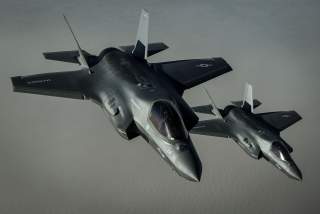Flying Tin Cans: Meet the 5 Worst Fighter Jets to Ever Head to Skies
Who made this list?
Bell’s P-59 Aircomet was America’s first attempt at building a jet fighter. However, compared to its British and German contemporaries—the Gloster Meteor and the Messerschmitt Me 262—the P-59 was an abysmal failure.
The United States has built many great fighters over the years. The P-51 Mustang, the F4U Corsair, F-86 Sabre, F-15 Eagle, F-16 Fighting Falcon and the F-22 are among the best warplanes this country has ever produced. This article is not about those machines.
(This first appeared in late 2015.)
There have been plenty of times when American ingenuity has fallen flat on its face. This article is about the dregs of U.S. warplane designs—the worst of the worst. But from each of these failures, we can learn something and make sure it never happens again. It’s only a failure of you don’t learn something from it.
Bell P-59 Airacomet:
Bell’s P-59 Aircomet was America’s first attempt at building a jet fighter. However, compared to its British and German contemporaries—the Gloster Meteor and the Messerschmitt Me 262—the P-59 was an abysmal failure.
In fact, during tests against Lockheed P-38 Lightnings, Republic P-47 Thunderbolts and a captured Mitsubishi Zero, it was discovered that the P-59 offered no advantage over the conventional piston-engine fighters of the time. Moreover, in many cases the piston-engine fighters outclassed the new jet.
The P-59 had a top speed of only 413 miles per hour—roughly equivalent to the P-38. Ultimately, the P-59 proved to be of little use except as a test vehicle, but it did set the stage for later, more successful projects.
Vought F7U Cutlass:
The U.S. Navy didn’t have an easy time introducing jets onto the carrier flight deck. One early effort was the Vought F7U Cutlass—known derisively to its pilots as the “Gutless Cutlass.” The Cutlass was not only severely underpowered with its pair of Westinghouse J46-WE-8B turbojets; it was also plagued with immature systems—especially its problematic hydraulics.
Indeed, retired U.S. Navy Rear Adm. Edward Lewis "Whitey" Feightner—a former Blue Angel— told the Smithsonian’s Air & Space Magazine that he offered his resignation on the spot when he was told the team would fly the Cutlass. “The Cutlass could be made into a pretty good flying machine with a few modifications,” wrote F7U-3 pilot John Moore in The Wrong Stuff, Air & Space reported. “Like a conventional tail, tripling the thrust, cutting the nosewheel strut in half, completely redoing the flight control system, and getting someone else to fly it.”
Grumman F-11 Tiger:
Grumman is famous for building some of the Navy’s best warplanes, but the F-11 Tiger wasn’t one of those. In fact, the F-11 is one of the few aircraft in history that’s managed to shoot itself down—literally. During a test flight, a Grumman test pilot who was testing the jet’s 20mm cannon managed to run into the very shells he had just fired.
The problem with the F-11 was less the airframe itself than the engines. The aircraft’s Wright J65-W-14 engines were extremely unreliable and burned gas at a high rate. As a result, the Navy was not happy with the Tiger. Naval aircraft—because of the unforgiving at sea environment—must have good range and highly reliable engines.
The Tiger was quickly retired after serving for only about thirteen years.
Convair F-102 Delta Dagger:
The Convair F-102 Delta Dagger was originally designed to be a high altitude, high speed interceptor that would destroy the hordes of Soviet bombers that the were expected to attack the continental United States in case the Cold War turned hot.
Designers built the delta wing jet around a powerful Pratt & Whitney J57-P-25 afterburning turbojet, an advanced fire-control system and an internal weapons bay. All initial indications showed that the jet should be a spectacular performer—until it flew. The prototype couldn’t even break Mach 1.0.
The Delta Dagger had run into what was then a newly discovered phenomenon called transonic wave drag. The aircraft had to be completely designed using the Whitcomb area rule, which basically states an aircraft must have an even longitudinal cross-sectional area distribution to minimize transonic drag. The redesigned F-102 had a “Coke bottle” configuration. Some versions of the story suggest the jet’s new fuselage design was actually inspired by actress Marilyn Monroe’s figure rather than a Coke bottle.
The reconfigured F-102 could eventually hit speeds of Mach 1.22, but the jet never really met expectations. Eventually, it was completely designed into a configuration that ultimately resulted in the much more successful F-106 Delta Dart.
F-35 Joint Strike Fighter:
The Lockheed Martin F-35 Joint Strike Fighter is not necessarily a bad plane—however, it is years late, grotesquely over budget nor is the aircraft likely to ever deliver what its designers originally promised. The F-35 is a case of massive over ambition to develop one base airframe that can be adapted to replace half-dozen specialized jets. The result is an expensive jack-of-all-trades, but a master of none.
Moreover, the requirements for the F-35 were set at a time when future threats were unclear. The requirements were set to fight in an environment that was less intense than what might be expected had the Soviet Union not collapsed, but more strenuous than what is required for a low end conflict like Syria or Iraq. Those who set the requirements did not anticipate the reemergence of China or the anti-access/area denial threats we are now starting to face.
The result is an aircraft that is not equal to meeting the emerging challenges facing the nation in the Western Pacific.
Dave Majumdar is the former defense editor for The National Interest.
Image: U.S. Department of Defense

